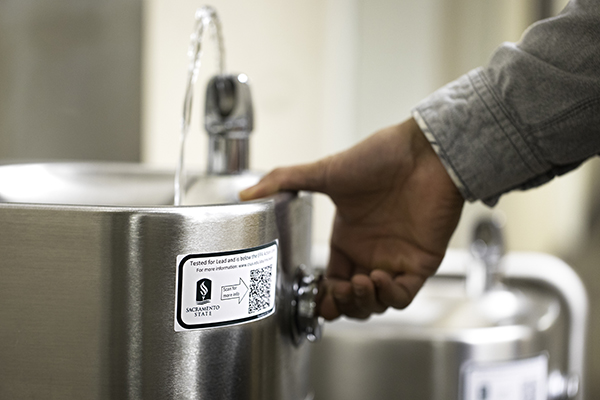Multiple rounds of testing confirm that all drinking water at Sacramento State meets or exceeds federal and state safety standards.
Soon, checking test results for nearly every drinking fountain on campus will take no more than the swipe of a smartphone.
These efforts come less than one year after a student research project led to the discovery of elevated lead levels in water from some campus fountains. Since January 2017, nearly 1,000 drinking-water sources have been tested for lead contamination. When 42 were determined to have lead levels at or above the mandated 15 parts per billion (ppb), University leaders and consultants immediately launched a comprehensive remediation plan to remove, replace or repair affected sources.
 (Sacramento State/Andrea Price)
(Sacramento State/Andrea Price)“Safety is our top priority on campus,” says Sac State President Robert S. Nelsen. “I appreciate the quick action by on-campus teams to shut down and arrange for the re-testing of identified sources. We will continue to retest water sources periodically on campus.”
Work is ongoing to place at least one filtered water-filling station in every building on campus, says Daryn Ockey, director of facility operations.
“The newly installed stations include filtration systems that remove lead and chlorine from drinking water, and include an LED filter-status indicator for when a filter change is necessary,” says Ockey. “Having the filter at the end where the user is drinking the water means that the water is in its cleanest form for the consumer.”
The new fountains, expected to all be installed during the spring semester, also include a “green ticker” that informs users of how many 20-ounce plastic water bottles have been saved from waste.
Sometime early in the Spring semester, all water-quality results will be at the fingertips of the campus community through an innovative technology program that increases transparency and accountability.
“For consumers interested in checking on the most recent water-quality readings, look for stickers placed on each fountain with a unique QR code,” says Gary Rosenblum, senior director for Risk Management Services. “When scanned, the code links directly to the most recent test results for that exact fountain, providing everyone with instant information they can use to be better informed.
"Our website will also provide links to government information about lead so people can better educate themselves and, hopefully, reduce concerns.”
The Environmental Protection Agency does not require testing for schools served by a public water system. However, Sacramento State leaders decided to follow California State Water Resources Control Board recommendations for water sampling at K-12 schools and its action recommendations, which include “reducing lead levels to less than 15 parts per billion.”
“This is not a fix-it-and-done situation,” Rosenblum says. “We are continuing to move forward with the same level of concern. We will continuously test water, and if we find any fountain with levels of lead above the EPA action level, we will address it and fix it. We will also update the QR code on each fountain as new test results come in.”
It’s not uncommon for lead to seep into water supplies especially from older pipes and fixtures. Most susceptible to elevated lead levels are fetuses, infants and children up to age 6.
“Safety and health of our students, faculty and staff is a top priority for the University,” says Mike Lee, vice president for administration and chief financial officer. “We will continue to keep the communication channels open to listen to concerns and to share progress we have made.”
For the complete data base of all water test results on campus, visit the water-quality page on the Sacramento State website. - Anita Fitzhugh
